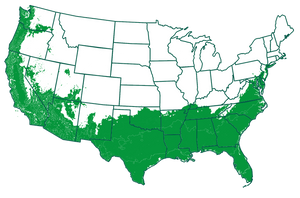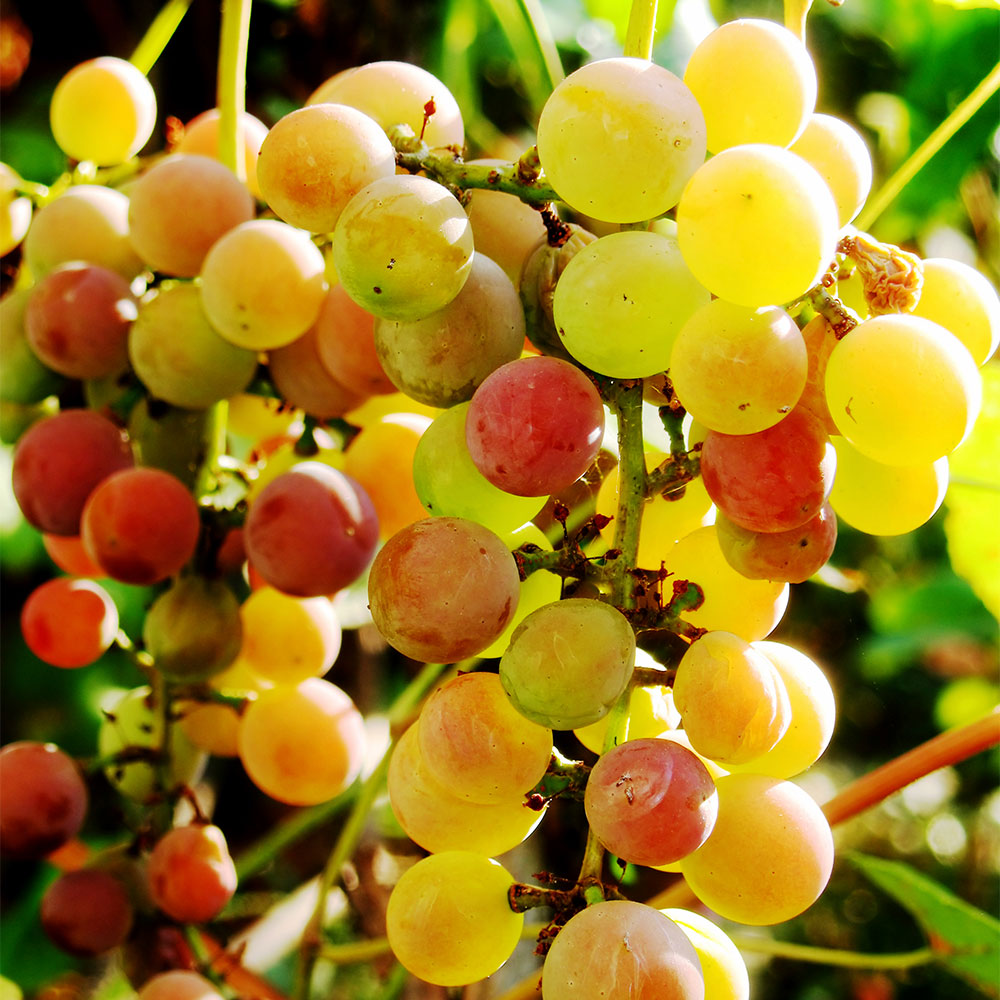* Images shown are of mature plants

Have questions? Talk with our Plant Experts (800) 973-8959
An Abundant Harvest of Sweet Grapes
Summit Muscadine Grapes are sweet and delicious.
Easy to Grow
The Summit Muscadine has been referred to as the 'beginner's vine' because once planted, it requires no maintenance. Planted in full sunlight, it's a prolific bloomer that produces an abundance of juicy grapes year after year. It is hardy and disease resistant and can grow as far as Zone 10.
A Different Type of Grape
This grape, also referred to as Scuppernong, has a slightly tougher skin than other popular varieties. Their clusters are a bit smaller as well, but there is no shortage of volume or taste. Expect them to be ripe early August through September. You'll enjoy watching it grow. It's a gorgeous plant that will wrap around a trellis or fence - and a great addition to a pool or patio area.
Cross-Pollination
The Summit Muscadine requires cross-pollination to produce. So select another of our outstanding grape varieties to pair with this vine and get ready for an abundant harvest of Summit Muscadine grapes! We suggest the Triumph Muscadine Grapevine for cross-pollination.
Order now for fast delivery!
Planting & Care
It's Easy to Plant & Care for Your Summit Muscadine Grapes
Summit muscadine grapes are bronze-gold in color and sweet to the taste. They are so delicious, you won’t be able to get enough! This variety is known as Vitis rotundifolia and will need a pollinator to fruit. These grapes perform their best in USDA growing zones 7-10 in full sun. Summit Muscadine Grapes are fast growers, maturing to a height of 12 feet tall and 5-8 feet in width.
Location: When planting summit muscadine grapes, find a location that offers full sun and moist, well-draining soil. Avoid shaded areas as fruit set/production will be reduced in the absence of sun during the growing season. Muscadines are a vine and will require some type of trellis to grow on properly.
Planting Instructions:
1) Dig your hole 3 times the width and slightly shallower than the root ball.
2) Loosen the soil, in and around the hole so the roots can easily breakthrough.
3) Use your fingers to separate the roots of your summit muscadine vine and gently position downward in the hole. The top of the root flare (where the roots end and the trunk begins) should be about an inch above the surrounding soil.
4) Begin to backfill the site, tamping down the soil as you go.
5) Apply water to settle the soil and remove any air pockets that may have formed then mulch to retain soil moisture.
Watering: Water regularly for the first year by giving your plants about 1 inch of water (1-2 gallons) a week. Directly moisten the roots but avoid spraying or misting the grapes. After the vines are a bit more established, they will seldom need watering. Be watchful for leaf drop, this is an early warning sign that you may be overwatering.
Pollination: Most species of grape are self-fertile but a good rule of green thumb is to always plant in pairs. This will assure you a healthy yield of fruit come harvest time.
Fertilizing: Apply a 1/4 pound of formula 12-12-12 or 10-10-10 fertilizer in an 18-inch circle around each vine in April. Re-apply every 6 weeks until July during the first year of growth. In the second year, apply fertilizer in March, May, and July increasing the dose to 1/2 pound per vine. Be sure the fertilizer is not closer than 21 inches from the trunk.
Pruning: Balanced pruning maintains the vine’s form, size, vigor, and next season’s fruiting wood. Pruning should be done when the vines are dormant in late winter or early spring. Do not prune when vines could freeze, because the new growth can be brittle and can damage easily. The foliage around the grape clusters can be removed to expose the fruit to sunlight in a short growing season. During your first growing season, multiple shoots will begin to grow and the vine may become bushy. Some trim their plants back to just one or two shoots. Others prefer to let them grow so they may have a better selection to choose from during the following winter’s pruning.
Harvesting: Taste is the best determining factor if it’s time to harvest or not. When fruit appears. Test its ripeness by picking a few grapes from different areas and tasting them. If the grapes are sweet, start picking as they ready for harvesting.
Tips:
*Grapes will not continue to ripen after picking so be sure not to pick them too prematurely.
*Color and size are not necessarily good indicators of ripe fruit. Only pick the fruit after you’ve tasted it and are certain it is ready.
Shipping Details
Estimated Shipping Time: Most orders ship immediately. As noted on the website, some items are seasonal, and may only ship in spring or fall. Once your order is shipped, you'll receive an email with a tracking number.
| Amount of Order | Shipping Charge |
|---|---|
| Less than $49 | $19.95 |
| $49 + | FREE SHIPPING! |
Product Details
| Mature Height: | 12 ft. |
| Mature Width: | 5-8 ft. |
| Sunlight: | Full Sun |
| Growth Rate: | Fast Growing |
| Harvest Time: | August - September |
| Botanical Name: | Vitis rotundifolia |
| Does Not Ship To: | AK, AZ, CA, HI, ID, NY, OR, WA |
| Grows Well In Zones: | 7-10 outdoors |
| Your Growing Zone: | # |





